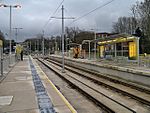Halal Inn

The Halal Inn was an alcohol free inn and temperance bar in the United Kingdom. It was designed for Muslims. It is located in Oldham, Greater Manchester and opened in December 2007. It was owned by Azizur Rahman and Muzahid Khan. They bought and converted the Westwood Inn to the Halal Inn. The bar served soft drinks, fruit juice, non-alcoholic spritzers, tea, and coffee but no alcohol. The inn also was home to a restaurant that serves traditional Asian and Middle Eastern food such as poppadoms, chicken pakora, seekh kebabs and the lamb dish saag gosht. There was also a steam room and a prayer room. The inn ran a snooker league, a Carrom league, and a monthly Islamic quiz night. Although the customers were predominantly male and Muslim, people of all backgrounds could frequent the inn.Cited as closed down, owner 'gone away'.
Excerpt from the Wikipedia article Halal Inn (License: CC BY-SA 3.0, Authors, Images).Halal Inn
Featherstall Road South,
Geographical coordinates (GPS) Address Nearby Places Show on map
Geographical coordinates (GPS)
| Latitude | Longitude |
|---|---|
| N 53.5427 ° | E -2.1291 ° |
Address
Featherstall Road South
OL9 6HL , Werneth
England, United Kingdom
Open on Google Maps







